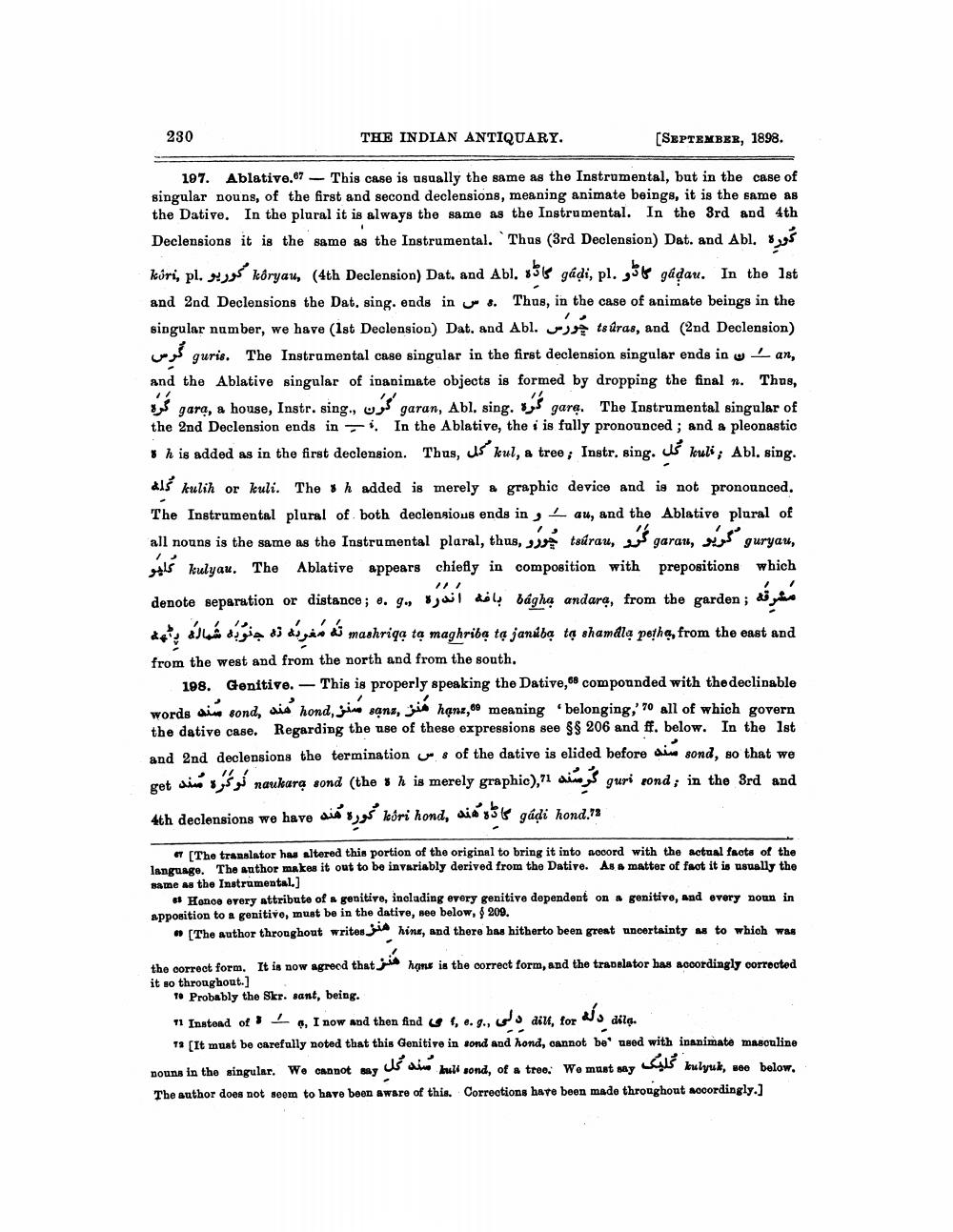________________
230
THE INDIAN ANTIQUARY.
(SEPTEMBER, 1898.
197. Ablative.67 - This case is usually the same as the Instrumental, but in the case of singular nouns, of the first and second declensions, meaning animate beings, it is the same as the Dative. In the plural it is always the same as the Instrumental. In the 3rd and 4th Declensions it is the same as the Instrumental. Thus (3rd Declension) Dat. and Abl. 8295 köri, pl. gyds kôryau, (4th Declension) Dat. and Abl. 83's gádi, pl. 9515 gâdau. In the 1st and 2nd Declensions the Dat. sing. ends in ws. Thus, in the case of animate beings in the singular number, we have (1st Declension) Dat. and Abl. b ts dras, and (2nd Declension) wogol guris. The Instrumental case singular in the first declension singular ends in w an, and the Ablative singular of inanimate objects is formed by dropping the final n. Thus,
gara, a house, Instr. sing., US garan, Abl. sing. 53 gare. The Instrumental singular of the 2nd Declension ends in -i. In the Ablative, the i is fully pronounced ; and a pleonastic 8 h is added as in the first declension. Thus, us kul, a tree; Instr. sing. Iš kuli; Abl. sing. als kulih or kuli. The 8 h added is merely a graphic device and is not pronounced. The Instrumental plural of both declensious ends in, au, and the Ablative plural of all nouns is the same as the Instrumental plaral, thus, uus tsūrau, es garau, viss guryau, 45 kulyau. The Ablative appears chiefly in composition with prepositions which denote separation or distance ; o. gMjal delp bágha andare, from the garden ; di ultimo des allá degia di dsgin at mashriqa ta maghribą tą janibą tą shamdla potha, from the east and from the west and from the north and from the south.
198. Genitive. - This is properly speaking the Dative, compounded with the declinable words aine sond, sis hond, join sana, ji hạnz, meaning belonging,' '0 all of which govern the dative case. Regarding the use of these expressions see $S 206 and ff. below. In the 1st and 2nd declensions the terminations of the dative is elided before ai sond, so that we get in sy's g naukarą sond (the 8 h is merely graphic), 71 din 3 guri rond ; in the 3rd and 4th declensions we have sis syys kori hond, sie's'sts gáại hond.73
The translator has altered this portion of the original to bring it into accord with the actual facts of the language. The author makes it out to be invariably derived from the Dative. As a matter of fact it is usually the same as the Instrumental)
# Honos overy attribute of a genitive, inelading every genitive dependent on a genitive, and every noun in apposition to a genitive, must be in the dative, see below, 209.
. [The author throughout writes die hins, and there has hitherto been great uncertainty as to which was
the correct form. It is now agreed that jus hone is the correct form, and the translator has accordingly corrected it so throughout.] ** Probably the Skr. sant, being.
Inntond of _ , I now and then find US 6,.g., colo diu, for as dilg. T3 [It must be carefully noted that this Genitive in sond and hond, cannot be used with inanimate masculine nouns in the singular. We ornnot say us sim buli sond, of a troo: We must may calls kulyuk, soo below. The author does not soom to have been aware of this. Corrections have been made throughout accordingly.]




